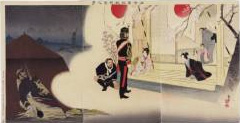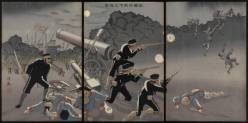
Throwing Off Asia – Lesson 01
Reading A Visual Primary Source
Introduction
In this lesson, students are introduced to the skills of reading a visual text and concept of visual literacy that underpin this unit. They are also introduced to the medium of Japanese woodblock prints, the primary historical documents at the core of Throwing Off Asia. Students will practice “reading” woodblock prints of the Sino-Japanese War of 1894 to 1895 using two complementary conceptual strategies—one specifically for visual materials (the Five C’s) and one for historical source materials of any kind.
Part A of this lesson provides a brief introduction to Japanese woodblock prints of the Meiji period (1868–1911) and is a building block of all lessons in this unit.
National History Standards (Word doc)
Objectives
At the conclusion of this activity, students will be better able to:
1. Understand visual literacy.
2. Apply a consistent strategy for reading and extracting meaning from visual texts.
3. Apply a set of questions for examining historical source documents that contain written text.
Time Required
1-2 class periods and optional homework
Materials and preparation
Students should be introduced to Japan’s Meiji period and the Sino-Japanese War through their textbook or teacher lecture prior to this lesson.
LCD projector and Internet access.
Internet access for all students.
Handouts 01-A (Word doc), 01-B (PowerPoint), 01-C (PowerPoint), 01-D (PowerPoint), and 01-E to be copied and distributed, or projected via overhead or LCD projector.
Procedure
Part A: A brief introduction to Japanese woodblock prints
1. To work successfully with the primary visual sources in Throwing Off Asia, students will need a brief introduction to the medium of Japanese woodblock prints. Distribute Handout 01-A, “An Introduction to Woodblock Prints,” or direct students to the handout in the student section of the Throwing Off Asia curriculum.
After students have completed the reading, check for understanding through class discussion of the following points. As an alternative, the teacher may present the points of Handout 01-A through a short lecture.
Woodblock prints date back to the early 1600s in Japan. From the beginning, they were a form of popular culture that could be created inexpensively and then mass produced.
Woodblock prints became very popular in Japan’s Tokugawa period (1603–1868). Because woodblock prints could be mass produced cheaply, they were an ideal art form for the growing urban populations of the time period. The subjects of woodblock prints were the the interests of the common folk—entertainment, beautiful women, actors, etc.
Because they were cheap to produce, cheap to buy, printed in mass quantities, and captured subjects of interest to common people, woodblock prints were never considered high or valued art. The were the equivalent of pop art of our own time—for example, rock posters or calendar art.
During the early Meiji period (1868–1890), woodblock print subject matter changed, and woodblock prints became a very popular medium for capturing and informing the public about the rapid changes and modernization of the period.
During the Sino-Japanese War of 1894 to 1895, before photography was widely available, woodblock prints were the primary medium through which news of the battlefront was conveyed to the Japanese people.
The woodblock prints of the Sino-Japanese War, like any war reporting, were subjective, reflecting Japanese perspectives, interests, and goals to a Japanese audience.
2. As a class, view “Making a Woodblock Print.” (The Shockwave plug-in is required.)
3. To conclude the introduction to woodblock prints of the Meiji period and Sino-Japanese War and set the stage for all lessons in the Throwing Off Asia curriculum, project the following paragraph from the Throwing Off Asia II Essay:
There was, however, a third factor behind the rediscovery of Meiji prints. As historians began to turn increasing attention to “popular” culture (beginning around the 1960s), and to place more weight on studying “texts” that went beyond written documents per se, graphics and images of every sort were suddenly recognized to be a vivacious way of visualizing the past. One could, in effect, literally see what people in other times and places were themselves actually seeing—and then try to make sense of this. One could “read” visual images much as one might read the written word—not simply as art, but also as social and cultural documents.
Part B: Analyzing visual texts using the Five C’s
1. Depending on student familiarity with visuals as primary historical documents, teachers may want to spend time introducing the concept of visual literacy. If students are already comfortable working with visual materials, this step may be omitted.
Write on the board the following sentence:
The Sino-Japanese War of 1894 to 1895 proved to the world that Japan had become a modern power.
Ask students to consider how they actually “decode” or understand the meaning of this sentence. In other words, what steps does a reader take (mostly unconsciously) to understand this or any written text? Students should understand that words are, in effect, symbols that have common meaning. At the same time, within written text, both facts and opinions can be embedded. Is the statement above factual? Which parts are factual? Which parts are open to interpretation? Explain to students that visual texts are interpreted and understood through the same process of analyzing images that convey both fact and opinion or interpretation.
Show students the visual text (below) on Handout 01-B. This may be displayed via LCD monitor, color overhead, or distributed in paper copy to students.

Ask students to consider how to read this visual for information and opinions on the Sino-Japanese War. Discuss what steps they need to understand what the author (artist) of this visual text wanted to convey to others. Discuss how “reading” a visual text differs from reading a written text.
2. Explain that in this lesson, students will work with a specific framework developed especially for reading visual materials and will apply this framework to an analysis of the woodblock prints of the Sino-Japanese War of 1894 to 1895. Students will then supplement that process by applying a set of questions designed for examining any historical text.
Distribute Handout 01-C, “The Five C’s: An Approach to Visual Texts,” or display it for the entire class. Introduce and discuss the framework, reprinted below, with the class.
The Five C’s:
Context. When was this made? What is the subject matter? What clues are given for a time frame? Consider material objects such as clothing, tools, machines, weapons, architecture, etc.
Characters. Who or what is portrayed here? A person or people? Specific groups? Symbol? What clues are given about who/what they are?
Color. What colors, if any, are used? What role do the colors play in conveying a message about the scene? Do you think they were used just for visual appeal? What is the mood or tone established by these colors?
Composition. Look at the use of space and the layout of figures and activity in the visual. Where is your eye drawn? Is this the main subject? Why do you think so? Is one image bigger than another? Is that to suggest a relationship? What kind of relationship? Is the entire space used? Why or why not? What is in the foreground? The background? Does either suggest importance?
Construction. Someone consciously constructed this image for a purpose. Who do you think made this? Why? For what audience? Who would connect with this image? Who would not?
3. Inform students that they will now practice this “reading” strategy with woodblock print art of the Sino-Japanese War.
Return to the woodblock print introduced in part B, procedure #1 (above). Through class discussion, proceed through the steps of the Five C’s to analyze this woodblock print.
5. For homework or paired group work, have students apply this exercise to a different woodblock print. Divide the class in half and assign each half one of the woodblock prints (below left; below right) found on Handout 01-D.


6. Allow class time for students to share their analyses. If students worked in small groups above, combine two small groups for sharing. If students completed the assignment for homework, have them report out to each other in small groups.
Part C: Analyzing visual texts using “Reading a Source Document”
7. Explain that there are many questions to ask and many ways to read a document. Explain that historians sometimes speak in terms of “interrogating” or “cross examining” a document. These terms tend to be associated with legal processes; ask students what these terms mean. In discussion, lead students to an understanding that interrogating or cross-examining a document implies critical and in-depth questioning for several purposes: to get as much meaning from a document as possible; to consider its reliability as historical evidence; to identify bias; to consider alternative interpretations or data; to put the text in a context. This analytical process differs somewhat from the Five C’s analysis that students worked with in the first part of this lesson, although some of the questions overlap.
8. Distribute Handout 01-E, “Reading a Source Document,” to all students and review the analysis questions completely to insure that all students understand them. Have students work in their same small groups to analyze the same woodblock print, but with this set of questions. You may want to subdivide groups so that one student in each group is looking at a particular category of questions, 1-5, on the Reading a Source Document handout.
When students have completed their analysis, lead a class discussion on their findings. As a class, discuss how the Reading a Source Document analysis sheet helped students to dig into the meaning of the documents they looked at. What questions were new to them? What questions surprised them? Did the questions on this analysis guide help them dig deeper into the woodblock print and/or help them see new aspects of the print? How did this analysis sheet round out their understanding of the document and the time and purpose for which it was produced?
Part C: Application/Extension
9. For homework or in-class assignment, divide students into four groups. Assign each group to go online to the Throwing Off Asia section of the Image Database. Instruct each group to pick one woodblock print of the Sino-Japanese War or Russo-Japanese War at random. Working alone or together with the image they have been assigned, students are to use the Five C’s and the strategies in Reading a Source Document to read the image. Explain that, based on their own analysis and understanding, they are to create 10 questions specific to the image they have been given that they would use to help another student read and understand that particular woodblock print. Clarify with students that for their written assignment, they are to move from the general questions used in the two strategies they have been working with, to specific questions that will help students see important aspects of the particular visual they are considering.
Follow up with class time for students to swap questions and woodblock prints and answer each other’s question sheets. Debrief in class.
10. Further application/extension. Assign students to find an article of national or international news in a newspaper or magazine and apply Reading a Source Document to that article.
Massachusetts Institute of Technology © 2008 Visualizing Cultures



